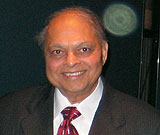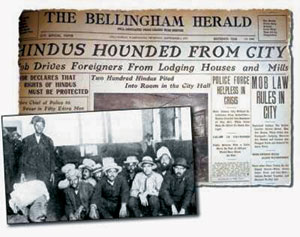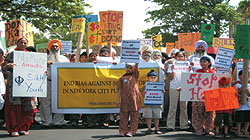|

|
|
Indians in America |
|
Migration, Settlement and Integration
|
|
By Inder Singh
|
|
|
Immigrants from India started coming to the United States of America at the beginning of the twentieth century. Most of them worked at menial jobs, lived in appalling conditions and in crumbling structures. Except a few, all were single, could not bring a spouse from India nor allowed to marry an American. For forty five years they lived in the shadows of American society. After a long struggle, in 1946 they got the right to US citizenship. Thereafter, they could buy property, get a job commensurate with their qualifications, marry a person of their choice, and were free to travel and visit India, the country of their birth. Indian nationals had lived for years in a free country
withou t freedom. However, after Indian nationals obtained political rights, there has been a dramatic change in Indian community’s contributions to the country they have adopted as their home. t freedom. However, after Indian nationals obtained political rights, there has been a dramatic change in Indian community’s contributions to the country they have adopted as their home.
The first part of this article describes the hardships, hostility, humiliation and bigotry the early settlers encountered and their sacrifices, perseverance and tenacity that defied all odds, while they managed a sustained campaign for political rights in the country of their domicile and hope, the United States of America. The second part describes the migration, settlement and assimilation of immigrants who came after the grant of citizenship rights and the liberalization of US Immigration laws. They comprised of professionals, high-tech workers, students and sponsored relatives. Several made laudable contributions in various ways to the country they have adopted as their home and also contributed significantly to the resurgence of India.
Beginning of Indian Immigration
In 1897, Queen Victoria of England and the Empress of India, included a Sikh regiment from the Indian Army in her diamond jubilee celebrations. On the return journey, the soldiers were sent back to India via Canada. Most of these soldiers were originally farmers and were fascinated with the potential for farming opportunities. They dreamed of returning to Canada after retirement. And some of them did return. India and Canada were both part of the British Empire and Canada became the destination of choice for many emigrants from India. Emigration from India to the USA started as a trickle while many came from Canada from the porous borders with America.
On April 5, 1899, four Punjabis who had worked in the British Royal Artillery in Hong Kong, landed in San Francisco and were allowed to stay in the United States by the US Immigration Service . The grant of permission for them was an encouraging signal for others to follow those four pioneers.
There was an abundance of jobs in the lumber industry in Pacific states of Washington and Oregon and ample available land to farm throughout the Sacramento, San Joaquin and Imperial valleys of California. On hearing about the economic opportunities in America, many more Punjabis headed towards this far away land. The new immigrants found jobs which the white workers would not do, usually menial jobs in factories, lumber mills, railroad construction, farms, etc. They were needy workers who accepted low wages, poor working conditions and very often traveled from place to place in search of work. The employers preferred Indians to the whites for their willingness to do any and all kinds of work. As the number of Indian workers increased within a span of few years, they started facing discrimination and hostility, in the same manner as the other Asians who had come before.
The Indians in the United States and Canada, for lack of US or Canadian citizens’
u nderstanding of religious or ethnic diversity, were commonly called “Hindus” (“Hindus”) irrespective of the faith of those Indians. The overwhelming majority of the arrivals from India were Sikhs who preserved their religious beliefs and practices by keeping their beard, long hair on their head and wore turban to cover them. They were easily distinguishable from other immigrant groups, but unfortunately, they were called “Rag heads”, a derogatory term used for the “Hindus” at that time. nderstanding of religious or ethnic diversity, were commonly called “Hindus” (“Hindus”) irrespective of the faith of those Indians. The overwhelming majority of the arrivals from India were Sikhs who preserved their religious beliefs and practices by keeping their beard, long hair on their head and wore turban to cover them. They were easily distinguishable from other immigrant groups, but unfortunately, they were called “Rag heads”, a derogatory term used for the “Hindus” at that time.
Indian workers were either unmarried or had come without spouses, hoping to save some money and return. They were paid low wages and could afford to live only in the poor squalid part of the town or in shanty structures provided by the lumber mills or farm owners. They lived frugally, subsisted on income that was prohibitive for locals to survive on and many shared crowded lodging to save money to pay off their debt or meet family obligations back in India. Their lifestyle and living evoked hatred and contempt from the Americans.
Indians legally admitted to the United States from 1899-1907 numbered only 1967 . The total number of Indians in the country, however, was larger as many Indians had come directly from Canada through the porous border between the US and Canada. But, concentration of Indians in a few small communities in the Pacific Coast states, particularly those with turbans, drew high level of visibility of their presence and provoked hostility from the Asiatic Exclusion League which carried propaganda against the “The Tide of Turbans” and “Hindu Invasion of America”.
Indians Expelled from Bellingham
Bellingham is located 85 miles north of Seattle in the state of Washington, 20 miles south of the Canadian border and had lumber and shingle mills. The owners needed a reliable supply of cheap manual labor and the new immigrants – the unskilled “Hindu” workers – met that demand. In 1907, the mills employed about 250 Indian contract workers who accepted jobs which white laborers had refused to do. They even performed work which could be in violation of labor laws but would not complain for fear of employer retaliation.
The unskilled white laboring men feared that competition from Hindu workers would displace them from their jobs and bring wages down. The union leaders wanted to maintain higher wage levels for their members and agitated bitterly against the employment of Indians. The union leaders approached the mill owners but failed to convince them to fire the Indian workers and discontinue their hiring. Some politicians perpetually starved for campaign money and union endorsement, willingly and openly backed the union demand.
The festering hostility of the union leaders and pent-up frustrations of the white laborers manifested in violence against Indians who had the least social or political power or protection in the city of Bellingham or even in the country. On Labor Day, September 2nd, 1907, more than a thousand union members and others paraded through the town to demonstrate their unity and show their strength. There was a beating of several Hindus which nearly resulted in a general disturbance. The union warned the mill owners that no Indians should be employed in the lumber mills or anywhere in Bellingham after Labor Day.
On the evening of September 4, 1907, a mob of 400-500 white men, predominantly members of the Asian Exclusion League, attacked Hindu dwellings, smashed windows and pulled the Indians from their beds. The rioters went on a rampage from mill to mill, finding as many Indian workers as they could while others ransacked the homes of the Hindus, stole their money, jewelry, bank passbooks and other valuables. They eventually rounded up about two hundred Indian workers, brandishing clubs triumphantly, and herded them to the City Hall basement where the Hindus stayed during the night for their alleged safety. The purpose of the racial attack was to “scare them so badly that they will not crowd white labor out of the mills .”
The nightmares of fright, brutality and vindictiveness forced majority of the traumatized Indian workers to leave Bellingham in search of safe haven. Some Hindu workers stayed nervously for one extra day in deadly fear of their lives just to draw their pay and get their checks cashed. Several departing Hindus expressed their disappointment for they had heard of America as a good place for laboring men, yet they were paid no better wages and became victims of violence and lawlessness in the presence of law enforcement officials .
Indians were British subjects but the British ambassador did not care to ask the American government for compensation for injuries or loss of property of the Indian workers. Since the media reported about the riots worldwide, the British Consul in Seattle visited Bellingham but did not care to meet or sympathize with the Indian nationals who suffered at the worst racial attack against them in America.
Some of the Indian mill workers went to Everett which is another town located sixty miles south of Bellingham, to work in the sawmills there. Two months later, on November 5th, 1907, over five hundred armed men attacked and beat the Indians, robbed them and destroyed their belongings. The result was similar to the incidents that occurred in Bellingham .Similar assaults also took place in some cities in California, such as Marysville, Live Oak, and other communities where the immigrants had settled. The Asiatic Exclusion League and the labor unions used violence and riots, apparently as an effective method of excluding the “Hindu” workers from jobs and residential communities.
The race riots had a devastating impact on the Indian community in the Pacific Coast. Indians had come in search of a chance for a better life for themselves and their families and worked even at menial jobs. They could never have anticipated that America – considered the best among civil societies – had people full of meanness, malice and ill-will against different looking people.
Daring Attempt to End British Colonial Rule in India
Higher education in American universities was a powerful magnet for young people even during that time. America provided them opportunity to “earn and learn” and so Indian students were attracted to seek admission in the US universities. However, several students upon graduation were not able to get jobs commensurate with their qualifications. The unfair and discriminatory practices were against the very ideals of liberty and freedom they had experienced in their university environment. The Indian students attributed the racial prejudice and discrimination to their being nationals of a subjugated country and thus wanted India to be free from the British slavery. They started fostering feelings of patriotism and nationalism among their fellow Indian immigrants.
Many Indians, students in particular, articulated nationalist feelings and started advocating freedom for their motherland, India from the British serfdom. They formed organizations to collectively assert their birthright to independence for India and explored ways and means to attain self-rule. Taraknath Das, a student, started publishing a magazine Free Hindustan in 1907 in Seattle, advocating armed rebellion against the British rule as a means for achieving independence. He also established the East India Association in 1911; G. D. Kumar started a Punjabi paper Swadesh Sewak in Vancouver. Har Dyal started Bande Mataram in 1909 for communicating his revolutionary ideas to the students and the Punjabi settlers who were already facing racial prejudice and discrimination.
Har Dyal who had come from England after relinquishing his scholarship and studies at Oxford University was identified with nationalist activities in the United States. He had been a faculty member at Stanford University for about two years. He inspired many students studying at the University of California at Berkeley and channelized the pro-Indian, anti-British sentiment of the students for independence of India. Two of his many student followers, Katar Singh Sarabha and Vishnu Govind Pingle later on played very prominent roles in the Gadar movement. Dyal’s fervor for India’s freedom spread beyond the university campuses to Punjabi farmers and laborers who had already been victim of racial attacks, discrimination and repression from the host community. A meeting of some patriotic and enlightened Indians was called on April 23, 1913, in Astoria, Oregon, where Har Dyal, Bhai Parmanand and others passionately spoke for throwing the British out of India and securing liberation by all means at their disposal. It was at this meeting that Hindustan Association of the Pacific Coast was formed with a major objective to liberate India with the force of arms from British colonialism, just as Americans had done more than a century ago, and help establish a free and independent India with equal rights for all. Sohan Singh Bhakna, a lumber mill worker in Oregon, was elected President, Har Dayal, as General Secretary. Har Dayal provided leadership for the newly formed association and was the central figure and the force behind the new organization.
...to be continued in the next issue
|
|
|
|
|
|
January 2009
|
|


|
|
|
|